Back To Home Page
Mt
Etna
Prelude: Volcanism on the Hyblean Plateau
Volcanism in eastern Sicily has occurred episodically since the middle Triassic,
producing voluminous mafic (that is, silica-poor) lavas and clastic (fragmental)
material, much of which was erupted and deposited below the sea level. The sites
of volcanic activity were located in the southeastern part of Sicily, on the
Hyblean Plateau (Monti Iblei), an area uplifted tectonically during the late
Pliocene and Pleistocene. The most recent major cycle of volcanism in that
sector lasted from the late Miocene (Tortonian) until the early Pleistocene
(~1.4 Ma) and showed a migration of eruptive centers northwards. A notable
feature of this volcanism was the brief duration of each eruptive event (maybe a
few years to several centuries) and the lack of major volcanic edifices, all
activity occurring from regional fissures controlled by the predominant tectonic
trends (WSW-ENE). The products of the most recent episodes of Hyblean volcanism
lie buried under hundreds of meters of late Pleistocene and recent alluvial
sediments, and their precise age is not known, but it appears that there is a
more or less continuous series of volcanics becoming progressively younger
towards north. On the northern margin of the Catania Plain, an area of tectonic
subsidence covered with fluvial deposits between Etna and the northern Hyblean
Plateau margin, volcanic rocks outcrop again, but these are considerably younger
than those of the Hyblean Plateau and are generally considered the earliest
manifestations of volcanism in the Etnean area.
First phase: "pre-Etnean"
Volcanic activity in the Etnean area began around 0.5 Ma (million years) ago.
This initial activity, the first of four main phases during the evolution of
Etna, was very similar in character to the latest Hyblean volcanism, and its
products were mainly submarine lavas and volcaniclastics of tholeiitic
composition (for more info of this type of basaltic rock. The famous outcrops of
Acicastello, a town some 10 km north of Catania, and nearby locations contain
pillow lavas and hyaloclastites produced by this early activity. It is generally
believed that this phase of volcanism took place in a vast marine gulf,
extending over part of the area occupied by the present Etna, which was
subsequently filled by sediments intermixed with volcanics helped by regional
tectonic uplift.
About 0.3 Ma ago, more eruptions occurred in various locations in the Etnean
area, - mainly on the SW side of Etna - producing transitional tholeiitic and
alkalic basalts (pigeonitic tholeiites, alkali basalts and trachybasalts).
This early phase of volcanic activity in the Etnean area is commonly named "Pre-Etnean".
The volume of these products is insignificant in comparison of the entire volume
of Etna's products, but in terms of time, this phase occupied more than half of
the history of the volcano.
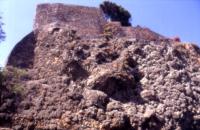 |
Left: Looking up the cliff of the
Acicastello fortress. The cliff consists of tousands of "pillows", the most
common type of submarine lava and possibly the most widespread lava type on
Earth.
Right: On the eastern side of the
Acicastello cliff, densely packed pillow lavas are in discordant contact
with hyaloclastites (a breccia consisting of volcanic glass and of pillow
fragments). The contact whose significance is poorly understood is marked by
a broken line in red color. |
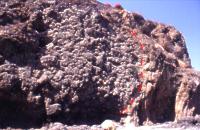 |
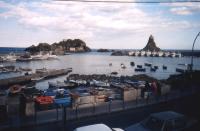 |
Left: The picturesque harbor of the village
of Acitrezza, some 2 km north of Acicastello, with the two largest of the
islands known as the "Ciclopi" or "Faraglioni", April 1999. The largest
island, to the left, is Isola Lachea.
Right: Outcrop of columnar basalt on the
shore of Acitrezza. The tops of the hexagonal or pentagonal columns form the
"mosaic" pattern of the surface. Such columns form during the cooling and
contraction of lava (or shallow intrusions). Photo taken in April 1999. |
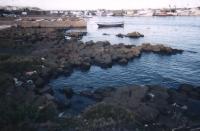 |
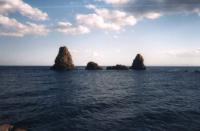 |
Left: The smaller, southernmost islands of
the "Ciclopi", seen from the harbor of Acitrezza, April 1999.
Right: The highest of the "Ciclopi" of
Acitrezza (known as "Faraglione grande" or "Faraglione della Madonna"), seen
from the harbor of the village in April 1999. The base of the rock consists
of magmatic rock, possibly formed by an intrusion which uplifted marine
sediments (visible at the summit of the rock). The white patch about half
way up the rock is a statue of the Madonna. |
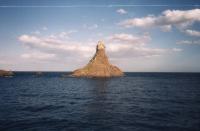 |
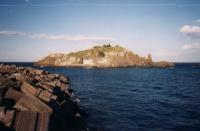 |
Isola
Lachea, the largest of the "Ciclopi" of Acitrezza, seen from the harbor of
the village in April 1999. The island consists mostly of magmatic rock,
probably formed by a shallow intrusion. The island is now a protected area. |
Second phase: "Ancient Etna"
The
second phase of volcanism at Etna, called "Ancient Etna", began with more
localized eruptions (such as the Paterṇ eruptive center, SSW of Etna, dated at
168 plus/minus 10 ka=thousand years). Several authors (Romano, 1982, Romano et
al., 1979) have named these eruptive centers the "Ancient alkali eruptive
centers". It is assumed that a first large stratovolcano (the Calanna eruptive
center; 100-130 ka) was built at a later stage of this phase. The erupted magmas
were alkali basalts and hawaiites.
Third phase: "Trifoglietto II"
The
third phase of Etnean volcanism is generally named "Trifoglietto II" and was
characterized by the building of several overlapping stratovolcanoes:
Trifoglietto II, a large stratovolcano consisting of lavas and pyroclastics,
Vavalaci, and Cuvigghiuni being the most important of these volcanoes. Among the
products of these volcanoes, most were alkaline differentiated magmas (trachyandesites),
leading to a much more explosive volcanism than that of the earlier phases. The
growth of the stratovolcanoes was at times interrupted, and in most cases
terminated, by caldera collapse. The oldest dated products of this phase are
about 80 ka old while another datation higher up in the stratigraphy yielded an
age of about 63 ka.
Fourth phase: "Mongibello"
The
fourth phase saw the growth of the Mongibello stratovolcano whose evolution is
divided into three stages, Ancient, Recent and Modern Mongibello. Its oldest
dated products are about 35 ka old. During this phase, Etna produced the most
differentiated (trachytic) magmas of its entire history; this occurred about
15-16 ka ago and led to the eruption of ignimbrites (the deposits of pyroclastic
flows) which are visible in outcrops near the town of Biancavilla, on Etna's SW
flank. Ash from these highly explosive eruptions was distributed over a wide
area in the Mediterranean and has recently been identified in lacustrine
(related to a lake) deposits in the crater lakes of the Colli Albani near Rome (Calanchi
et al., 1996), about 800 km NNW of Etna! This event was probably accompanied by
the collapse of a caldera named Ellittico, a depression about 3 km in diameter
which has been filled by more recent eruptive products and partially eaten away
by more recent caldera collapse. After this period of trachytic magmatism, the
compositions of the erupted products became more mafic (that is, poor in silica
but with higher Mg and Fe contents), and the activity became predominantly
effusive.
Major caldera collapse occurred again several thousand years ago, forming the
Valle del Bove, a vast depression some 5 x 7 km across on the eastern side of
the mountain. The early stage of caldera formation was characterized by the
gravitational failure (sector collapse) of the eastern flank, producing a debris
avalanche whose deposits have only recently been identified by Calvari et al.
(1998) under a thick succession of fluvial deposits known as the "Chiancone" and
outcropping on the lower eastern flank of Etna. The most recent collapse event
that created the present shape of the Valle del Bove probably occurred only
about 3500 years ago, as revealed by ongoing studies by a British working group.
The growth of the modern summit cone of Etna was interrupted as recently as
~2000 years ago by caldera collapse (Piano caldera), in the context of an
unusually explosive (Plinian) eruption which probably occurred in the year 122
B.C. (Coltelli et al., 1998). The outline of the Piano caldera is still well
visible as a distinct slope break close to the base of the current summit cone,
its maximum diameter being about 2.5 km, with the rim being at about 2900 m
elevation. More recently there may have been minor caldera collapse affecting
only the area of the present summit cone, such as in 1669 when a large volume of
magma was drained from a possible storage area under the volcano during a major
eruption from Monti Rossi on the southern flank.
The activity of Etna during the past few thousand years has been characterized
by lava emission and Strombolian activity, punctuated at times by more explosive
episodes from the summit craters.






